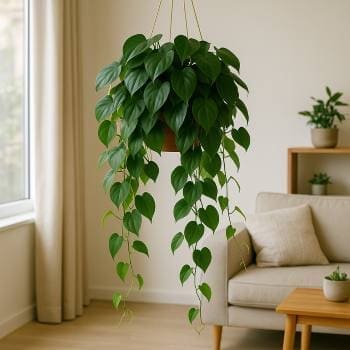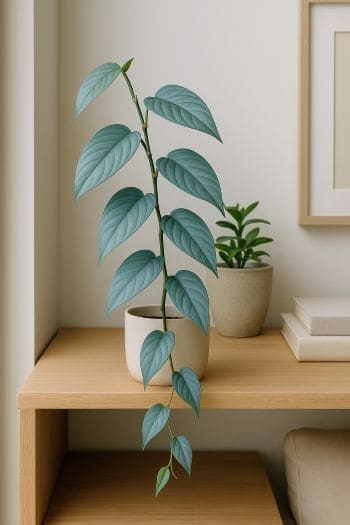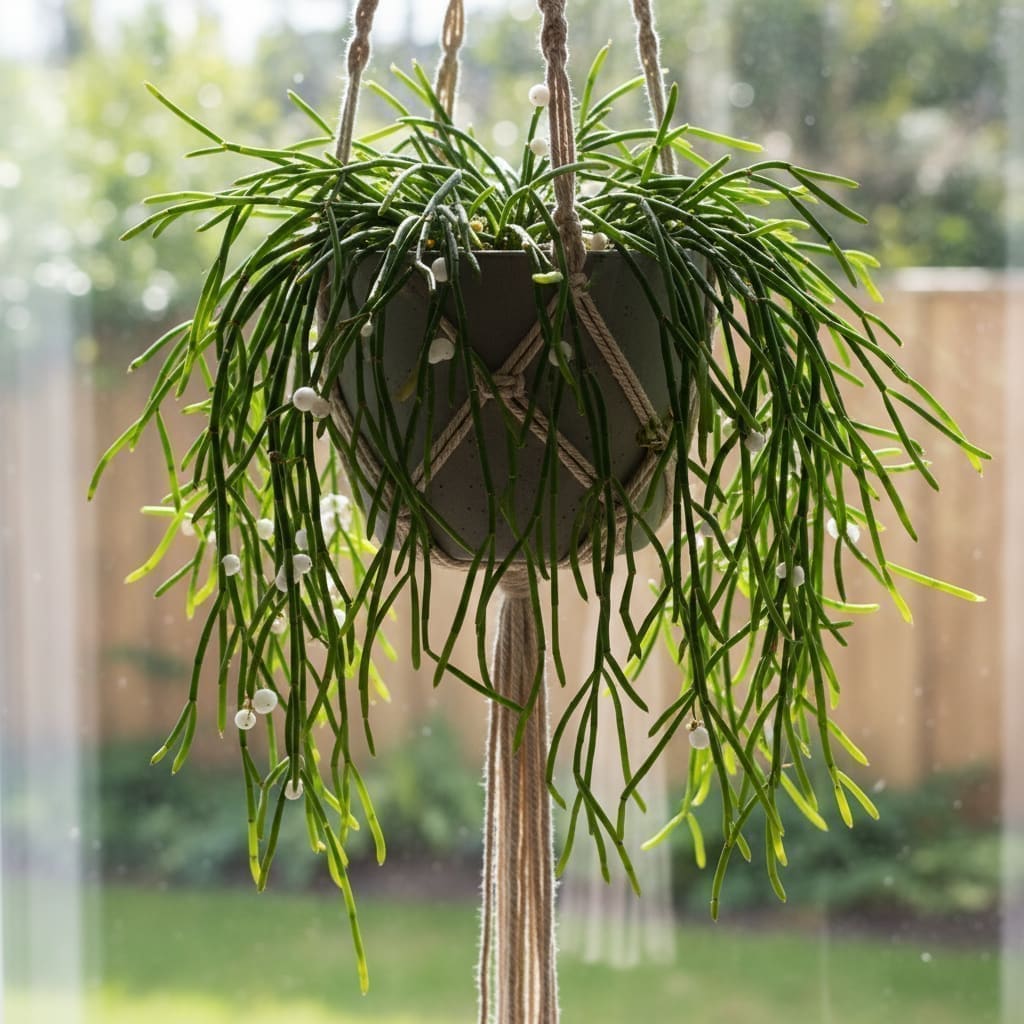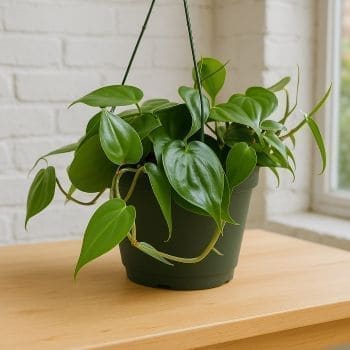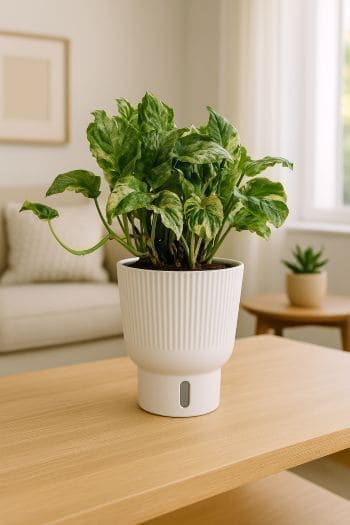Philodendron hederaceum (Heartleaf Philodendron) Care & Growing Guide
Overview
Philodendron hederaceum, commonly known as the Heartleaf Philodendron, is a popular tropical houseplant prized for its attractive, heart-shaped leaves and adaptable nature. Native to Central America and the Caribbean, this species thrives in warm, humid environments and is well-suited to a variety of indoor conditions. In its natural habitat, it grows as a climbing or trailing vine, using aerial roots to anchor itself to trees and absorb moisture from the air.
Its forgiving care requirements make it a favorite for both beginner and experienced plant enthusiasts. With the right conditions, it can grow vigorously and live for many years indoors.
Identification & Growth Habit
The Heartleaf Philodendron features slender, flexible stems with glossy, heart-shaped leaves that are typically deep green, though some cultivars display variegation. Leaves generally range from 2 to 4 inches long indoors, but can grow larger in optimal conditions.
Growth habit can be either trailing—spilling gracefully from shelves or hanging baskets—or climbing when provided with a support such as a moss pole or trellis. Aerial roots emerge along the stems, enabling the plant to attach to surfaces and climb vertically.
Light & Placement
- Preferred light: Medium to bright, indirect light.
- Tolerates: Low light, though growth will slow and variegation may fade.
- Avoid: Prolonged direct sunlight, which can scorch leaves.
Place the plant near an east- or north-facing window, or a few feet back from a bright south- or west-facing window filtered by sheer curtains. Rotating the plant every few weeks encourages even growth.
Watering & Humidity
Water when the top 2–3 inches of soil are dry. Use room-temperature water and ensure excess water drains freely from the pot. Avoid letting the plant sit in water to prevent root rot.
Humidity: Prefers moderate to high humidity (50–60%), but adapts to average indoor levels. To increase humidity:
- Mist leaves occasionally
- Use a humidifier nearby
- Group plants together to create a microclimate
Soil & Repotting
Use a well-draining aroid mix containing peat moss, perlite, and orchid bark. This combination retains some moisture while allowing air to reach the roots. Avoid compacted or heavy soils that hold excessive water.
Repot every 1–2 years or when roots begin to circle the pot. Choose a container with drainage holes, increasing pot size by only 1–2 inches in diameter to avoid overwatering risk.
Fertilizing
Feed monthly during the active growing season (spring and summer) with a balanced liquid fertilizer diluted to half strength. Reduce feeding in fall and winter when growth naturally slows. Overfertilizing can cause salt buildup and root burn—flush the soil with plain water occasionally to prevent this.
Pruning & Training
Pruning helps maintain the desired shape, encourages bushier growth, and removes any yellowing or damaged leaves. Use clean, sharp scissors or pruning shears to cut just above a leaf node.
For climbing growth, provide a moss pole, trellis, or other vertical support. Secure stems gently with plant ties or soft twine. For trailing displays, allow stems to cascade from shelves, hanging baskets, or tall planters.
Propagation
Philodendron hederaceum is easy to propagate via stem cuttings. Follow these steps:
- Select a healthy stem with at least 2–3 leaves and visible nodes.
- Using sterilized scissors, cut just below a node.
- Remove the lowest leaf to expose the node.
- Place the cutting in water or directly into moist, well-draining soil.
- If rooting in water, change the water every few days to keep it fresh.
- Roots typically emerge within 2–4 weeks. Once roots are a few inches long, pot into soil if started in water.
Common Problems
Pests
- Spider mites: Look for fine webbing and stippled leaves. Treat with insecticidal soap or neem oil.
- Mealybugs: White, cottony masses on stems and leaves. Remove manually and treat with horticultural oil.
- Aphids/Scale: Sticky residue or bumps on stems. Wipe with alcohol-dipped cotton swabs and apply appropriate control measures.
Diseases
- Root rot: Caused by overwatering or poor drainage. Remove affected roots and repot in fresh, well-draining soil.
- Leaf spot: Brown or yellow spots may indicate fungal or bacterial issues. Remove affected leaves and improve air circulation.
Toxicity & Pet Safety
Philodendron hederaceum contains calcium oxalate crystals and is toxic to pets and humans if ingested. Keep out of reach of cats, dogs, and children. Contact a veterinarian if ingestion is suspected.
Styling & Decor Tips
- Hang in a macramé planter to showcase trailing vines.
- Train up a moss pole for a lush, vertical accent.
- Place on a high shelf to allow stems to cascade dramatically.
- Pair with contrasting foliage plants for visual interest.
Varieties & Cultivars
- Philodendron hederaceum ‘Brasil’: Green leaves with lime-yellow variegation.
- Philodendron hederaceum ‘Micans’: Velvety, iridescent leaves with bronze undertones.
- Philodendron hederaceum ‘Lemon Lime’: Bright chartreuse foliage.
Buying Tips & Maturity
When purchasing, select plants with vibrant, unblemished leaves and firm stems. Avoid specimens with yellowing foliage, mushy stems, or signs of pests. Younger plants are often more affordable and adapt quickly to new environments, while mature plants offer instant fullness and longer vines.
Seasonal Care
- Spring/Summer: Active growth period—water and fertilize regularly, provide adequate light, and consider repotting if rootbound.
- Fall/Winter: Growth slows—reduce watering and feeding, maintain warmth, and protect from cold drafts.
FAQ
- How fast does Philodendron hederaceum grow? In ideal conditions, it can produce several new leaves per month during the growing season.
- Can it live in low light? Yes, but growth will slow and variegation may diminish.
- Should I mist my Heartleaf Philodendron? Occasional misting can help, especially in dry environments, but is not strictly necessary if humidity is adequate.
- When should I repot? Repot every 1–2 years or when roots become crowded.
- Is it safe for pets? No—Philodendron hederaceum is toxic to cats and dogs if ingested.
Sources: Wikipedia, The Spruce
